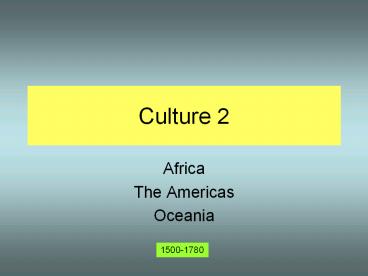Culture 2 PowerPoint PPT Presentation
1 / 14
Title: Culture 2
1
Culture 2
- Africa
- The Americas
- Oceania
1500-1780
2
Culture and Contact
- Last time we looked at cultures that had some
history of contact with the rest of the world - Today we turn to cultures that had little (or no)
contact with the rest of the world - The cultures of Africa, the Americas and Oceania
were profoundly transformed by contact with
Europeans as they borrowed freely and had
cultural forms imposed upon them
3
West Africa
- The most intense zone of contact in Africa was in
the West - Like the rest of the world, elites in these
societies commissioned artists to produce works
that reflected the elite view of the world - Cultural production centred around making
statues, masks, jewellery and the like
4
The Oyo Empire produced some of the worlds most
intricate bronze work
The Asante (or Ashanti) had access to gold for
their art production
Benin had a long tradition of producing pottery
and bronze art
5
The Slave Trade
- The revenue from the slave trade was concentrated
among small groups of elite traders who had
translated their wealth into political power - The increase in wealth also meant that more money
was being put into cultural production, leading
to a flourishing of West African arts and crafts
6
The Asante had access to large gold deposits
which was associated with royalty. The trophy
head was made of gld the carved box and
fertility doll were made out of wood.
7
Culture in the Americas
- Many cultural traditions of the Americas were
eradicated as Christian missionaries and
colonists converted natives to Christianity - However, many of these traditions survived
(despite Christian opposition) and formed part of
a hybrid culture made up in large part by people
of mixed ethnic or backgrounds, called mestizos
8
Many Spanish and Portuguese colonists married
indigenous wives to secure their place in the new
world. Many native Americans converted to
Christianity and incorporated those beliefs and
practices into a unique hybrid
9
Culture in Oceania
- The many different cultures of the Pacific Ocean
had lived in relative isolation from the rest of
the world until the eighteenth century when
European explorers arrived and brought them into
the global trade system - While some island cultures were able to maintain
their autonomy, others were brutally taken over
and had European culture imposed upon them
10
(No Transcript)
11
Scientific imperialism
- One of the driving forces of exploring the
Oceania and the South Pacific was the quest for a
scientific understanding of the world that
developed during the enlightenment - The search for scientific knowledge went
hand-in-hand with the search for commercial
opportunities and territories to populate with
European colonists
12
Captain James Cook (1728-1779) was the
quintessential enlightened scientist mixing
scientific curiosity with a spirit of
adventure. His voyages were widely publicised and
he and his scientific crew made detailed records
of plants and animals and precise maps. Popular
literature about the voyages captured the
European imagination. Cooks voyages served as
vehicles for conquest in Australia, pressing much
of the large continent into service of British
control.
13
Captain Cook in Hawaii
- When Cook and his ships reached Hawaii in 1778
Cook was believed by the natives to be a
representative of Lono, the god of feasts and
harvests - When Cooks ship returned damaged from a storm
the natives no longer believed that he was a
divine figure - A misunderstanding led the natives to kill Cook
and his crew
14
Conclusion
- Cultural production in West Africa experienced a
boom funded in large part by the profits from
the slave trade - A hybrid culture developed in the Americas that
would eventually be at odd with the mostly white
settlements of the British - In the Pacific, European exploration was fuelled
by scientific inquiry and the desire to find new
territory to conquer

